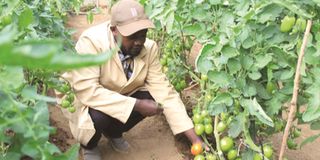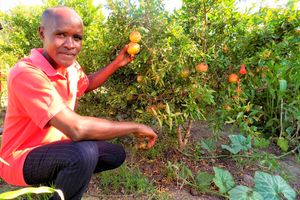Farmers saving Mother Earth using climate smart practices

What you need to know:
- Lake Naivasha basin hosts the Aberdare water tower, one of the major water towers in the country.
- It also boasts of diverse bird species, and about 70 per cent of flowers exported from Kenya are from this region.
The bumpy murram road leading to Wambekenya village, North Kinangop in Nyandarua County, is unsettling. There is barely anyone by the roadside except for the surviving trees making up part of the Aberdare Forest. The dark clouds are getting darker and the weather is chilly. There are patches of bare land with countless tree stumps breaking the beautiful pattern of the long pine and cypress trees.
We get to an even bigger patch, about three acres, but here, things are different. There are no tree stumps and young pine trees are growing alongside Irish potatoes and snow peas, co-existing as harmonious plant siblings.
We meet John Maina at his three-acre farm, where he has planted snow peas. On the right side of his farm, a tributary feeding into River Malewa babbles with admirable serenity. It is one of the main rivers pouring into Lake Naivasha, whose source is the Aberdare Forest. The forest stares at us, and the view of its existing canopy is refreshing.
Where we are, however, human activities like deforestation destroyed part of the forest, and farmers like John are trying to restore that through agroforestry.
“These trees are given out by the Kenya Forest Service; we plant and maintain them. When they reach a maximum of three years, they will have formed a canopy, which covers the area and we cannot farm anymore, so we move to another bare land,” he tells Healthy Nation.
The small scale farmers in this area mainly grow vegetables, snow peas and potatoes; infusing Sustainable Consumption Practices (SCP).

Gabriel Mwangi at his tomato farm in Moi Ndabi, Naivasha.
According to the United Nations Environment Programme, SCP refers to the use of services that respond to the needs that bring an improved quality of life while minimising the use of natural resources and harmful materials as well as the emissions of waste and pollutants over the life cycle of the service. This is in a bid to keep nature safe for future generations.
In this case, the farmers try to plant their crops and maintain the soil by avoiding the use of harmful fertilisers, which drain into Lake Naivasha; affecting aquatic life therein.
“We therefore have to work and conserve the environment and also ensure that the river has fresh water that drains into Lake Naivasha,” explains John.
Some few metres from John’s farm is Jane Wanjiru’s three-acre farm whose produce has already sprouted. The purple flowers of the Irish potatoes are a proof of life.
“I have been farming for 15 years and before joining this project, farming was the last resort because I yielded nothing. In 2018, the Goalan project enlightened my farming practices because we were taught sustainable ways of farming,” she says.
The project works towards making the horticultural sector in Kenya contribute to an inclusive and green economy by a large uptake of SCP practices.
“As part of the training, I have learnt a number of SCPs, which have helped me. I have been able to farm and at the same time conserve the environment by doing agroforestry. I also do soil management by planting grass strips for controlling soil erosion. I test my soil so as to know what fertilisers to use because the chemicals may go down to the river; affecting the lake and its inhabitants,” she adds.
To avoid using such toxic fertilisers, she uses integrated pest management
(IPM). The United Nation’s Food and Agriculture Organisation (FAO) defines IPM as the careful consideration of available pest control techniques and subsequent integration of appropriate measures that discourage the development of pest populations.
For Jane, she practices crop rotation; ensuring that she does not plant the same crop for two farming seasons. She also does proper spacing, which helps in minimising the risk of pests and diseases. If she has to plant anything on her farm, the seeds she uses have to be certified.
But on the Eastern side of Lake Naivasha, despite being the same region, the conversation on conservation shows the reeling impacts of climate change.
The morning that Healthy Nation team visits, we find farmers in Moi Ndabi area complaining of frostbites — an injury caused by freezing of the skin and underlying tissues when there is too much cold.
Here, there are no forests but huge tracts of bare land, some with farm produce struggling to grow. We meet 29-year-old Gabriel Mwangi, whose farming method is different from his neighbours’. One of his neighbours has planted maize, but its dwarf size already predicts the unrewarding yields.
He explains his observation of climate change in Moi Ndabi over the years and why he has chosen to use alternative farming methods.
“When I was young, we used to have planting calendars, for example, in January, everyone went out to prepare their farm and wait for the onset of the rain to start planting. Currently, we cannot rely on that because the weather pattern has really changed. This year, for instance, from January to mid-June, we have not had any reliable rainfall. People planted thinking it would rain, but there is no rain,” he says.
In his 8 by 15-metre greenhouse, he has planted tomatoes and a few vegetables side by side.
We disinfect our shoes before getting in — that is one of the ways Gilbert manages the risk of getting pests and diseases into his small farm. But unlike the two farmers practising agroforestry whose water supply is guaranteed, Gilbert has to find other means to water his crops.
“We have long dry spells here and the only way to ensure I get enough yields is by having a sustainable source of water. I use drip irrigation. We make sure that the little water we have can enable us to produce sustainably for a longer duration,” he says.
Gilbert, like Jane, also uses IPM control systems for pests and diseases.
“I do proper spacing as part of my IPM. When I space, there is no darkness or cold, preventing diseases such as mildew. I use decomposed manure so that the soil can retain moisture and be fertile at the same time. I also make sure that I do crop rotation as part of my IPM management — this is to reduce the reoccurrence of diseases,” he explains.
Caroline Njiru, World Wide Fund for Nature (WWF) Rift Lakes-Naivasha Sub-Landscape Programme coordinator, explains that sustainable agriculture is a stubborn challenge in Naivasha, especially where Gilbert lives.
Lake Naivasha basin hosts the Aberdare water tower, one of the major water towers in the country. It also boasts of diverse bird species, and about 70 per cent of flowers exported from Kenya are from this region.
“Agriculture is a huge threat to biodiversity and we should know that how people produce their food is important. If at all we will bend the curve in terms of biodiversity loss and look at how agriculture is done, then our natural resources are at stake. Agriculture and how it is done has an impact on biodiversity. Freshwater, pesticides and all…drain into the lake affecting terrestrial and aquatic life,” she explains.
She observes that farmers should embrace alternative farming methods like Gilbert in order to adapt to the climate that has changed.
“The weather here is extreme, it gets too cold or too hot so farmers are not able to produce, but with the greenhouses, they are able to produce more all-round the year on a small piece of land. If you talk to many farmers, they will tell you that the production has gone down, that is why we are coming in and telling them to diversify, don’t come in and plant maize yet it is doing badly,” she says.





